New Looks
Yes, friends, after 18 months my publishing instincts have reasserted themselves: I’ve become bored by my own blog, so I’m redesigning it. Actually, on some twisted little level I’m becoming bored by
an ohio boy travels the world with msf
Yes, friends, after 18 months my publishing instincts have reasserted themselves: I’ve become bored by my own blog, so I’m redesigning it. Actually, on some twisted little level I’m becoming bored by
But about that boredom, you’re thinking. Can’t be a midlife crisis – doesn’t selling up all my stuff and leaving the
 Nah – just shaking things up a bit so I don’t fall into a rut here. Never ceases to amaze me how much I’ve adapted to the most mind boggling things. Says my friend Ondrej (that’s Mr. Risk to those who’ve actually read the text rather than just skimming the photos), “Surprise? After 16 [in his case, a piddly four] months in
Nah – just shaking things up a bit so I don’t fall into a rut here. Never ceases to amaze me how much I’ve adapted to the most mind boggling things. Says my friend Ondrej (that’s Mr. Risk to those who’ve actually read the text rather than just skimming the photos), “Surprise? After 16 [in his case, a piddly four] months in 
 OK, OK, enough about my summer makeovers and my failed love life. You want to know what you’re looking at. Well, they’re the Eastern Qing Tombs, duh! They don’t appear in any of your tour guides, you say? Haha! Finally got out of the tourist books! And it’s well worth it. Sorry folks, you won’t see these on any guided tours soon: they’re too far outside Beijing to fit neatly in the three-day packages that combine Wall & Ming Tombs, Forbidden City, Tiananmen, Temple of Heaven, and the mandatory stop at Yashow so you can purchase all those pirated clothes China’s no longer making or selling. (Yeah, right, just like all those pirated CDs that we can’t buy here any more.)
OK, OK, enough about my summer makeovers and my failed love life. You want to know what you’re looking at. Well, they’re the Eastern Qing Tombs, duh! They don’t appear in any of your tour guides, you say? Haha! Finally got out of the tourist books! And it’s well worth it. Sorry folks, you won’t see these on any guided tours soon: they’re too far outside Beijing to fit neatly in the three-day packages that combine Wall & Ming Tombs, Forbidden City, Tiananmen, Temple of Heaven, and the mandatory stop at Yashow so you can purchase all those pirated clothes China’s no longer making or selling. (Yeah, right, just like all those pirated CDs that we can’t buy here any more.)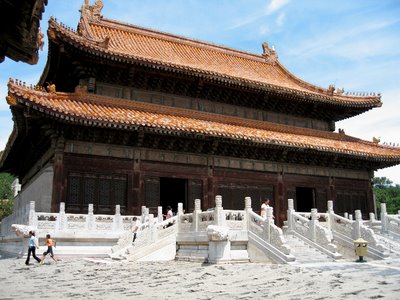
Now about those tombs…ever the boring academic, let me inform you that the Qing Dynasty (as noted in my last posts from the seashore) established itself after storming down from the wild northeast (aka Manchuria) and driving out the last of the Han Chinese Dynasties in 1644. (These dynastic dates all make it sound so neat and clean, but of course it really wasn’t – it was civil wars and gradual disintegration throughout
What’s interesting about the Qing Tombs is they’re divided: almost everyone’s over here, on the east, spread along the slopes of these mountains at the edge of this gorgeous valley. Then there’s Yongzheng, Kangxi’s fourth son, who came between the other two and was – though quite ruthless – said to be one of the finer Qing emperors. Kangxi, living as long as he did and of course surrounded in the Forbidden City by all those concubines and wives, managed to produce quite a few progeny, of whom something like 13 were sons. If you think your family’s had some inheritance disputes, just imagine how Kangxi’s sons settled their differences! Yongzheng killed all but one (the most loyal) of his brothers and ruled from 1722-1735. When it came time to plan his tomb, though, he suffered some remorse, and chose a separate location far out west of town for himself, his wives and his concubines.
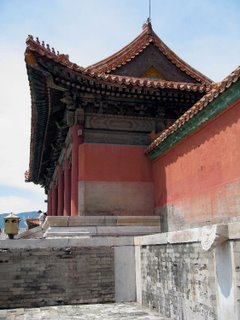
Socio-cultural aside about ruthlessness. In Chinese history – and to tell by my (modern, smart, female) Chinese teacher, still in contemporary culture – it’s accepted among men and emperors. Ruthlessness is just fine. My reading of Chinese history is currently turning up a few ruthless women, invariably the wives or concubines of emperors (or in the case of the Gang of Four, party leaders), and without exception they (Lu Hou 吕后 , Ci Xi 慈禧) are seen as the personification of evil. Just an interesting little note: as my teacher says, women shouldn’t hold power. Bad for them. But men – hell yeah, kill your brothers. No problem! Gotta be cruel to be kind, gotta be firm to rule well, and certainly gotta be a man to rule!
Tidbits about the tombs: there were far more than we could see in a full afternoon, surrounded by fields, orchards and chestnut trees, scattered like jewels along the verdant hillsides at one end of a hill-encircled valley. (Great 风水 - aka feng shui - one understands.) Only a few have been maintained and/or restored – rebuilt, as the critics would say. One great joy is how you feel they’re left in a fairly natural state of deterioration; indeed, Marg and I discussed whether thepeeling and faded paint at one tomb is original from when the emperor was buried there in the mid 1800s, or at least from dynastic-era maintenance (after all, the post-dynastic era didn't bother much with tomb maintenace until at least the early 1980s, one assumes, given the various obstacles those years presented).
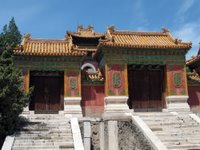
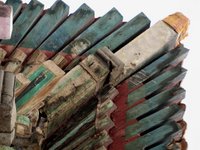
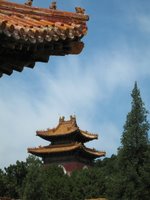
 Remember the Baoji Children’s Center? MSF ended our management of the project March 31, and it was reborn as Baoji Xinxing Aid for Street Kids, to our knowledge the first domestic NGO serving the needs of street children to be registered and recognized in China. As you can imagine, I’m rather proud of this and of my role in encouraging and supporting the staff to push for this outcome to MSF’s exit from the project.
Remember the Baoji Children’s Center? MSF ended our management of the project March 31, and it was reborn as Baoji Xinxing Aid for Street Kids, to our knowledge the first domestic NGO serving the needs of street children to be registered and recognized in China. As you can imagine, I’m rather proud of this and of my role in encouraging and supporting the staff to push for this outcome to MSF’s exit from the project.
Managing Xinxing now are our former national staff colleagues, advised by the former FieldCo for MSF, who’s chosen to stay on for some time to help the new NGO get up and running, establish a stable funding stream, and hopefully find ways to make this model viable for other regions of China, by reducing costs while maintaining appropriate quality and so on – essentially making it a development project, away from its roots in a humanitarian aid organization. In any case: I remain in touch with the center, and last week I hosted a visit from Margaret, the now-consultant. At the same time my Baoji friend Davey – who showed me around Xi’an last December – took up my invitation to visit Beijing. He’s just graduated from technical school in Xi’an, and is spending the summer volunteering at the center before continuing his studies in a related field in Xi’an.
I used their visit as an excuse for an overnight excursion, which ended with the Qing tombs you’ve been seeing, but which began with a bus ride to Jixian, the nearest town to the tombs (50km) and an overnight in a lovely courtyard building there. Here we are enjoying our bus ride and a beery dinner after the late bus arrival in Jixian.




It often seems every fifth hill in China is a sacred mountain or tourist destination in some sense. After the bus ride and the late night of food and beer, we were up at 6 to begin our 4WD assault on the bumpy roads of Panshan. This is an overpriced tourist trap, compared to any other mountain or temple I’ve been to in China. I don’t recommend it – there are far nicer places, even within Beijing proper, that cost less and are way easier to reach. This may be why it appears in none of my many tourist books: but I gotta admit, I did get a kick out of FINALLY getting off the foreign tourist routes, 16 months after I arrived here. Let me stress: the foreign tourist route: as we descended, the stream of 4WDs bumping their way up the rutted and muddy track was quite astounding, given the frankly mediocre quality of the attractions on offer. Still and all, the surrounding mountains made a lovely backdrop and we enjoyed the views and the air.
The
In June, though, my friend Catherine asked me to join her and some classmates on a weekend excursion to Shanhaiguan and Beidaihe, the beach resort 30 km or so south of Shanhaiguan. I couldn’t say no to such an offer, and we had a wonderful weekend – despite rain in Beidaihe.
Shanhaiguan is also known as “the first pass under heaven,” meaning the first place where people can pass the wall, working inland from the ocean. In fact, for quite a long stretch, it’s the only place where the wall passes through flatland, in the several kilometers in from the ocean. This, of course, was the point – to protect the fertile and productive Han Chinese heartland from the nomadic tribes that from earliest history had occasionally raided Chinese communities and headed off with livestock and other valuables.


The section right next to the sea is called Laolongtou, or old dragon's head. Don't ask me why. The Chinese love to say that various geologic formations look like various animals. I almost never see it. But it's certainly lovely, and an interesting feeling to think that you're at the end of a wall that stretched uninterrupted and well-guarded, at various points in history, right up to the edge of the Takla Makan desert.
We were interested to note lots of Russian being spoken here. Seems this area is a popular warmer-water resort area for people from the Russian far east - Vladivostok in particular, I guess. Indeed, the water was quite nice when we did some rock-skipping and wading! :-)


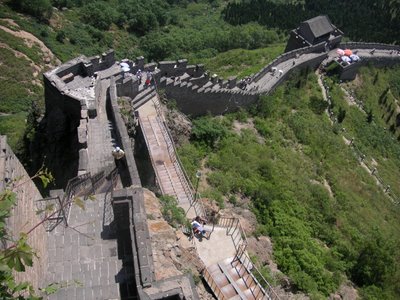

Between the ocean and the hills lies a flat coastal plain that's perhaps 10 kilometers wide. At the end of the plain, the wall again climbs steeply into the hills that separate the north China plain from inner Mongolia, and Manchuria. These shots are various views of the first stretch of Wall climbing into the hills. As you can see, it's pretty darn steep!
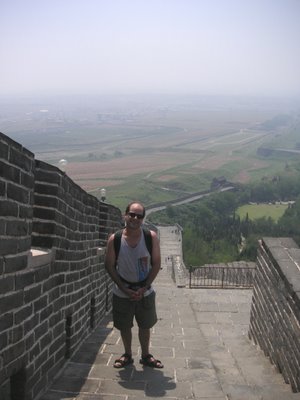


Here are two shots of me at the section of the wall on the inland side of Shanhaiguan town, where it climbs the first set of mountains in from the sea. In the first, I've got the wall running downhill toward the plain by the ocean; in the second, I've got the wall climbing uphill and inland behind me. Then there's a shot of Catherine coming out of the ladder used to climb the high tower. It's same high tower you see behind me in the second shot. Quite the aerobic workout, to climb this - or just about any - section of the wall! And not necessarily for those who don't love heights!

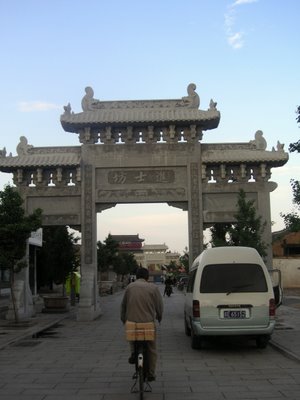

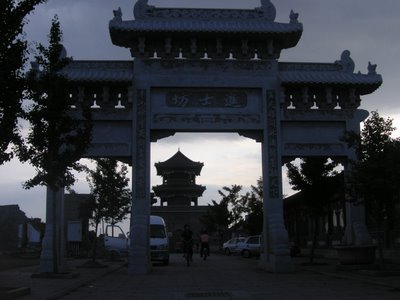

We headed to Shanhaiguan on Saturday, after getting rained out on the beach at Beidaihe (further down, you can see some wet shots of the rainy beach! :-) ). So we arrived a bit late in the day, and enjoyed a stroll around the old part of town - within the old town walls, which still stand for most or all of the town, it seemed - before finding dinner. As you can tell from all the picutres of courtyards and little lanes I've been showing you, I was quite taken with this town. I found it retains a small-town charm, with little lanes and corners to discover, while also holding the excitement and elegance of being the first station on the Great Wall right at the ocean, and a very important town strategically.